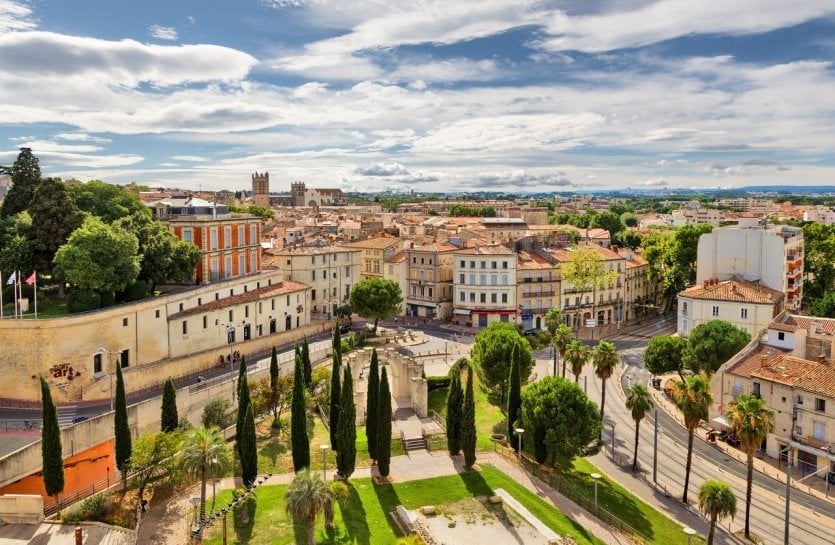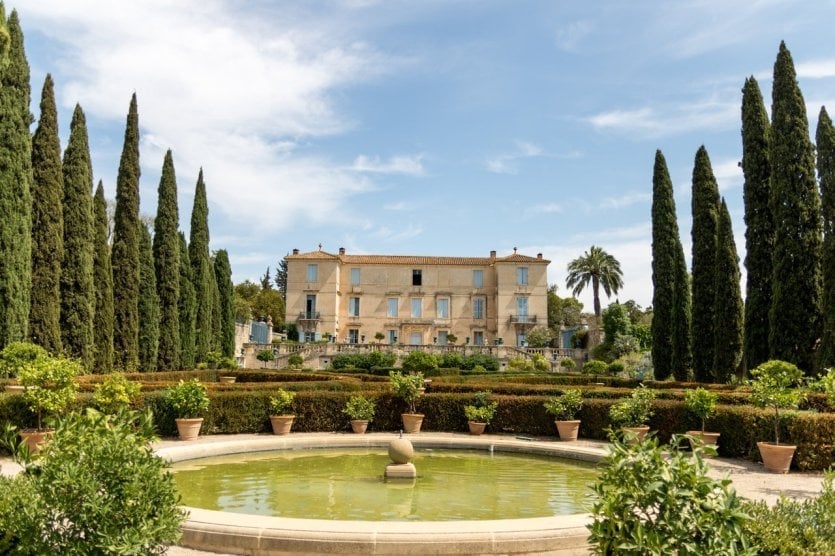
Montpellier is a must-see in the south of France. Its Mediterranean charm and rich heritage leave no one indifferent. It's worth taking the time to stroll through its different districts, contemplating the beautiful buildings and pushing on to the more recent areas. Montpellier has inspired contemporary architects throughout its history. The prefecture of Hérault is home to fascinating museums, relaxing gardens and never fails to awaken the taste buds with its gastronomy and wines from the surrounding vineyards. Here's everything you can see and do when you decide to spend two days in Montpellier. As part of an extended weekend, it's tempting to escape to the surrounding area, where many wonders await visitors.
Day 1: Écusson, Musée Fabre, Musée de l'Anatomie, Antigone...

Saturday morning:
The discovery of Montpellier begins at Place de la Comédie andEsplanade Charles-de-Gaulle. Here you can admire the Comédie Opera House, stroll among the plane trees and take in the many private mansions hidden away in the district. There are 80 of them in the city, and although most are closed, their facades are sublime, and some of the open doors give a glimpse of the pretty inner courtyards. Here we are in the Écusson district, one of Montpellier's must-sees. It's always a pleasure to get lost in this maze of medieval alleyways, to see the fortress-like Saint-Pierre cathedral and to stumble across charming squares such as the Place de la Canourgue. Then it's time to visit the Musée Fabre. In this remarkable building, you'll discover works ranging from the 14th century to the present day, with Flemish paintings and others from neoclassicism and romanticism.
Saturday afternoon:
After lunch, we continue with an unusual visit to the Museum of Anatomy, also known as the Museum of Horrors. It offers a fine overview of the evolution of medicine over time. You'll discover specimens preserved in jars, representations in wax and plaster, surgical instruments and more. A strange museum, but one that never fails to fascinate visitors. Then it's back into the fresh air for a stroll around the Antigone district, built in the 1980s by Catalan architect Ricardo Bofill. This is a superb example of post-modern architecture. From squares to fountains, you can look up at any moment to admire the monumental curves of the buildings, clearly inspired by the architecture of ancient Greece. You'll also find chic pubs and brasseries overlooking the River Lez. The perfect opportunity for a refreshing break.
Saturday evening:
Montpellier is a student city. The city is always lively, especially at weekends. You can extend your stay in the Antigone district or return to the historic center for a drink and a bite to eat. Enjoy a seafood dish with a glass of local white wine, such as Picpoul-de-Pinet. Those who wish can consult the cultural program at the Opéra Comédie or the Corum. Numerous bars host concerts, and you can even go on until the end of the night in one of the city's clubs.
In or out of season, Montpellier is a city that shines all year round!
Day 2: Arc de Triomphe, Promenade du Peyrou, Halles Laissac, Musée des Arts Décoratifs...

Sunday morning:

Visitors who didn't take the time to visit the Arc de Triomphe the day before must make a point of doing so. You can get there by taking rue Foch, a magnificent Montpellier thoroughfare with its 19th-century buildings. You can then admire the details of the monument built in honor of Louis XIV, with its sculpted medallions and inscriptions. We continue with a stroll along the Promenade du Peyrou. Chances are you'll do so under a blue sky, as Montpellier isone of the sunniest cities in France! Locals and visitors alike enjoy strolling along the avenue of century-old plane trees, admiring the basins, the equestrian statue of Louis XIV and the old water tower. Being at the highest point of the town, you also enjoy a beautiful panorama of the Cévennes and the sea. You'll need to keep an eye on your watch to make sure you have enough time to get to the Halles Laissac. This is where gourmets stock up on local produce for lunch.
Sunday afternoon:
In the afternoon, we head to another of Montpellier's remarkable museums, the Musée des Arts décoratifs Sabatier d'Espeyran. Housed in a prestigious 19th-century town house, visitors will discover richly decorated salons, goldsmiths' and silversmiths' pieces and ceramics. A wonderful glimpse into the lifestyle of aristocratic and bourgeois society in the 18th and 19th centuries. If you're in the mood for a bit of fresh air, you'll be pleased to know that you can reach the sea quickly from the city center. By streetcar and bus, it takes just 30 minutes to get to Palavas-les-Flots, one of the 15 best places to visit around Montpellier. So, in no time at all, you're ready to set up your towel and soak up the sun and the reflections of the Mediterranean.
Day 3: Château de Flaugergue, plant garden

Monday morning:
For those of you who have put Monday aside or are taking advantage of a bank holiday, this morning is a great opportunity to visit the Château de Flaugergue. It's a shame to spend time in the capital of the Hérault region without discovering a Montpellier folly! Château de Flaugergue is a magnificent 18th-century Tuscan-style building. Inside, you'll find an incredible staircase, Flemish tapestries and distinguished furnishings. Outside, a green space designated a Jardin Remarquable awaits visitors, with a terrace, formal gardens, statues and Anduze vases containing the citrus fruits grown on the estate. As wine-growing is always in the spotlight, the tour is rounded off with a wine-tasting session. Click here to book your guided tour of the two wine châteaux, including a wine tasting session! With venues like these, Montpellier could be one of the 13 must-visit destinations for an EVJF in France.
Monday afternoon:
To round off this weekend in Montpellier, one of the 15 best destinations for a cheap weekend getaway, we take a leisurely stroll to the Lunaret zoological park, the second largest in France. there are 11 km of paths for you and your family to explore and observe animals from all over the world. In this free 80-hectare park, you can admire giraffes, lions, cheetahs, brown bears, ostriches, rhinoceroses, dromedaries, Iberian wolves and many birds. Please note, however, that the park is only open on Mondays when the day is a public holiday and during zone C school vacations.
Where to stay in Montpellier?
Montpellier offers a variety of accommodation options to suit all tastes and budgets. The simplest option is to stay in the city center, close to the places you want to visit. If you want to be right in the heart of the action, the historic center (Écusson) is an excellent choice. You'll be close to the main attractions, restaurants, stores and lively squares. The area around the famous Place de la Comédie also offers easy access to public transport, stores and restaurants.
Here are our favorite establishments!
- The best location: Enjoying an exceptional location, close to the train station, Place de la Comédie and the Écusson, the Hôtel Aragon is the ideal starting point for all travelers discovering Montpellier. Click here to book your room.
- The most authentic: Hôtel des Arceaux, a former 19th-century bourgeois residence transformed into a refined 3-star hotel full of charm and authenticity. Interested? Click here to book your stay.
- The most luxurious: Located just a few minutes from the historic center, the Pullman Pléiade is a 4-star hotel with a poolside rooftop and panoramic restaurant. Check hotel rates and availability right here!
What to do for a romanticweekend in Montpellier?
Montpellier has a multitude of places with a romantic atmosphere. Like the Promenade du Peyrou or the Château de Flaugergue, where you can stroll through the formal gardens and enjoy a glass of wine. Museum fans will always want to visit the Musée Atger, just next door. This is a completely different matter, as it houses a superb collection of prints and drawings from the French, Dutch, German, Italian and Flemish schools. Lovers can also take a short break from the city to go hiking at Pic Saint-Loup, in the heart of incredible craggy landscapes. It's one of the must-sees in the Hérault region. Or head to one of the most beautiful beaches in the area and walk with your feet in the water, such as the Espiguette and Petit Travers beaches.
What to do for the family weekend in Montpellier?
You're in the Hérault region and wondering what to do in Montpellier during a getaway with the kids? You could, for example, visit the Jardin des Plantes, a green lung in the heart of the city. This is France's oldest royal garden, created by a young doctor on the orders of Henri IV in 1593. Here, families will discover a bamboo forest, a hundred-year-old hackberry tree, orange trees, a lotus pond with carp and frogs, a garden of the senses with aromatic plants and a greenhouse housing several species of cactus. There's also the Lunaret zoo, a free park where you can see a wide range of animals from all over the world, including wildcats, rhinos, Iberian wolves, giraffes and many birds. Within the park, the Amazonian greenhouse is another kid-friendly spot. It recreates a real Amazonian setting, with the presence of 3,500 plant species.
What to do in Montpellier for free?
The best free activities in Montpellier are to discover its rich heritage, particularly in the Écusson district. Saint-Pierre Cathedral and Carré Saint-Anne are just some of the buildings you can visit without paying. As mentioned above, the Lunaret zoo is also free. The Pavillon Populaire is a photographic art space open to the public free of charge. Finally, you're free to stroll around the Jardin des Plantes or the Bassin Jacques Cœur. The Musée Fabre is free every first Sunday of the month.


